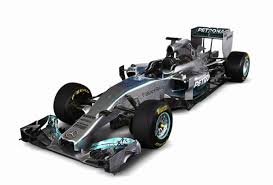It seems like a long time since the days when Red Bull ruled Formula One. That’s because it has been seven years ago. What’s more, Mercedes has become so dominant that some critics believe it’s the F1’s most dominant team of all time.
Mercedes’ transition into the top of the F1 chart started with the FI WO4. The car catapulted the Lewis Hamilton-led team from the fifth position in 2012 to second in 2013. Then Mercedes introduced the WO5 in 2014 and the team has had legendary success.
Statistically, the WO5 is the second most successful F1 car in history:
- 1988 McLaren—82.92%
- 2014 Mercedes—81.51%
- 2002 Ferrari—81.25%
- 2004 Ferrari—80.86%
- 2011 Red Bull—79.56%
To be clear, the 2014 WO5 won 16 out of 19 races. By comparison, the 1988 McLaren won 15 of 16 races. So, depending on how you interpret statistics, Mercedes ranks first or second. All the same, the WO5’s success boils down to several factors.
#1: An Innovative Design
Mercedes started developing the WO5 in 2012, borrowing ideas from the WO4 and perfecting them as much as they could do. To provide some context, engineers at Mercedes say the WO4 was the first car where everything was designed as it should.
So, when the car achieved great success in 2013, they had a blueprint for developing an even more successful car. The WO5 featured an engine with a turbo compressor and a turbine on opposite sides—both linked by a single shift.
The unique design gave the WO5 several significant benefits. For example, the car had very little turbo lag, in turn improving efficiency. It also helped reduce fuel and power consumptions consumption.
Another benefit of the WO5 design is that Mercedes used a small intercooler, which helped enhance aerodynamic performance. The compressor’s placement, at the front, also helped lower the car’s center of gravity—a boost in handling.
#2: Technically Powerless Competitors
Mercedes’ competitors became aware of the company’s groundbreaking design a little bit too late. As a result, they had a heads-up that their biggest rival had a unique engine and they knew the secrets used, but they couldn’t do anything about it.
According to Christian Horner, Red Bull’s CEO, his team could probably have beaten Mercedes in 2014 if it used cars with a similar engine. To expound more, Mercedes beat Red Bull by a measly one second on the straights. And that was because of the 50 to 70 horsepower added by its groundbreaking engine.
#3: Two Incredible Drivers
Like the 1988 McLaren, some people argue that the WO5’s great success might have less to do with its engine and more to do with the drivers. The WO5 debuted at the Australian Grand Prix with Nico Rosberg as the main driver. He won the event by 27 seconds.
An in-form Lewis Hamilton then took control of the automobile and used it to win the Malaysian, Bahrain, Chinese and Spanish Grand Prix events. By mid-season, Mercedes’ A-list drivers had clinched all but on event—the Canadian Grand Prix won by Red Bull’s Daniel Ricciardo.
It also failed to clinch one pole position, won by driver Felipe Massa of Williams. Otherwise, many F1 fans in 2014 had their money on the Mercedes team. Indeed, the team never disappointed: Sixteen championships, 18 pole positions, eleven 1-2 finishes and 12 fastest laps.
#4: Two+ Years of Dedication
As we mentioned earlier, the engineering process for the W05 lasted over two years. It started in 2011 when Mercedes brought in technical director Geoff Willis for one purpose: designing the fastest F1 car ever.
Mercedes then hired former Ferrari chief designer Aldo Costa, the man behind Ferrari’s success in the 2000s. It then brought in Paddy Lowe, the former chief technical director of Williams, John Owens and Mike Elliot, an aerodynamicist.
This team was tasked with perfecting every bit of the WO5. In all fairness, they had a blueprint of what was needed from the WO4. In all fairness, engineering a compressor located in opposite sides with the turbo was a new concept. And due to that, they had to work harder than any other team to make the car win races for Mercedes.







